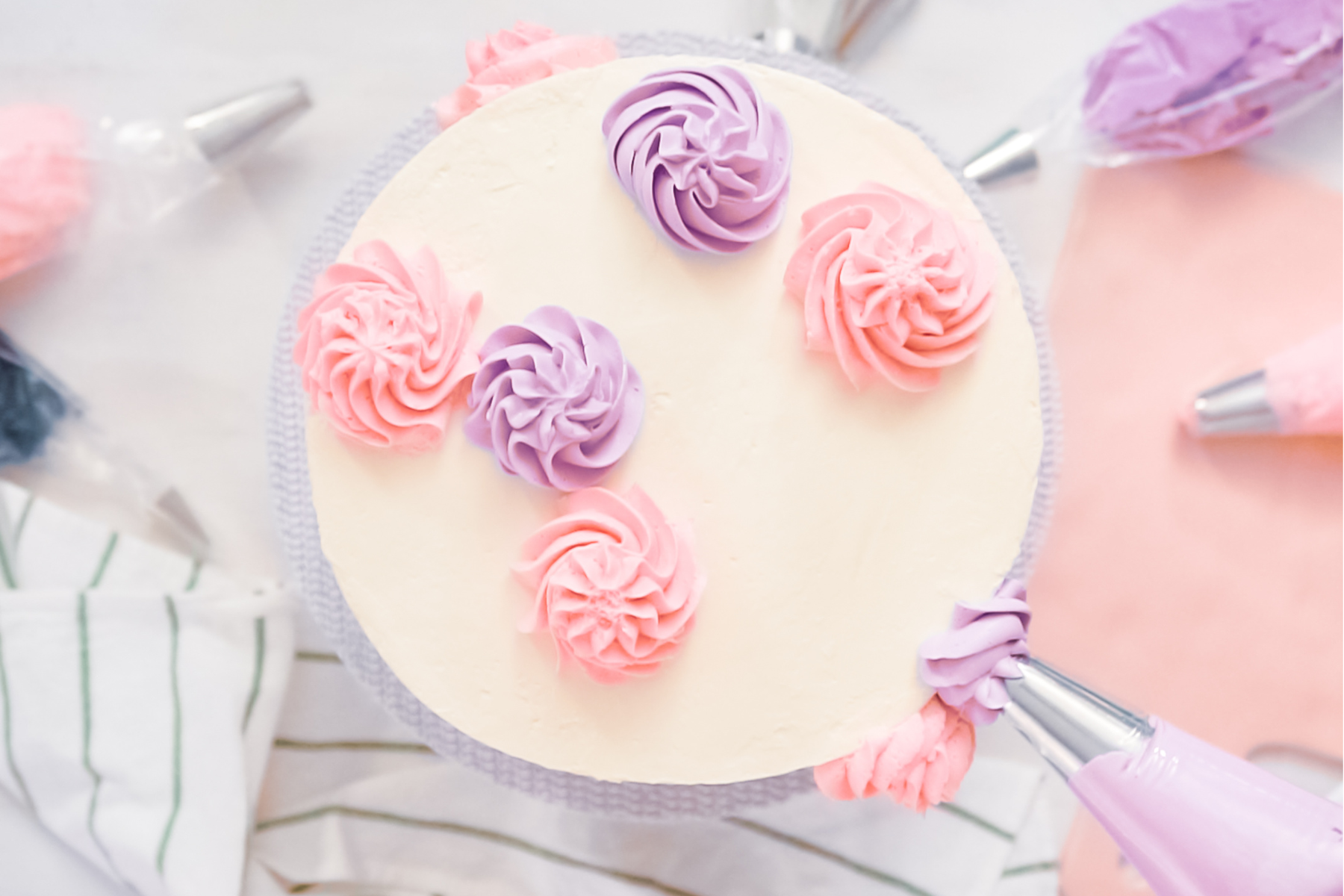The Secrets to Perfect American Buttercream
In this post, we’re diving into the secrets of making the perfect buttercream every time, from tips & tricks, to working through challenges, and climate changes.
This post may contain affiliate links. View our disclosure policy.
We all know that the secret to perfect buttercream lies in its texture – soft and spreadable, but not too runny or stiff. But achieving the perfect buttercream consistency can be a real challenge.
We've all been there – you start whipping up a batch of buttercream, only to find it's filled with pesky air bubbles, or it turns into a thick, hard mess in the cold. Don't worry, I've got you covered!
In this blog post, I'll share some insider tips and tricks to help you avoid air bubbles and navigate different climates to achieve that velvety-smooth buttercream every time!
Try my easy-to-follow, smooth & fluffy American Buttercream recipe!
How Climate Can Affect the Consistency of Your Buttercream
Climate can have a significant impact on the consistency of American Buttercream frosting, and understanding this influence is key to achieving perfect results, especially in a place like Houston, Texas, where the climate can vary.
Here's how climate affects buttercream consistency:
Temperature & Humidity:
The temperature and humidity levels in your environment play a crucial role.
In hot and humid climates, like Houston's warm and muggy weather, buttercream can become softer and more prone to melting.
This is because the butter in the frosting starts to soften at higher temperatures.
The humidity can also introduce moisture into the frosting, making it thinner.
Softening in Heat:
In hot weather, your softened butter may become even softer or even melt slightly when you mix it into the frosting.
This can lead to a runny consistency that's challenging to work with, especially if you're decorating a cake or cupcakes.
Thickening in Cold:
Conversely, in colder and drier climates, buttercream can stiffen up and become firmer.
This can result in a buttercream that's too stiff and difficult to spread or pipe. It may not have that desirable smooth and creamy texture.
Advertisement
Adjusting Consistency:
To combat the effects of climate, it's essential to be prepared to adjust the frosting's consistency as needed.
If you're in a hot and humid area like Houston, you may need to add more powdered sugar to thicken the frosting or use less liquid.
On the other hand, in a cold and dry climate, you might need to add a bit more liquid or allow the butter to soften longer at room temperature before using it.
For hacks on how to soften butter: Soften Butter Quickly with These Hacks
Trial & Error:
The key is to be flexible and willing to make adjustments based on your specific climate conditions. This often involves a bit of trial and error.
Start with the base recipe, and if you find your buttercream too soft or too stiff, gradually add more powdered sugar or liquid until you achieve the desired consistency.
In summary, climate, particularly temperature and humidity, can significantly impact the consistency of American Buttercream Frosting. Being aware of your local climate's tendencies and knowing how to adjust your frosting's ingredients accordingly will help you create the perfect buttercream for your desserts, no matter where you are.
Advertisement
Ways to Avoid Getting Air Bubbles in American Buttercream
Use the Paddle Attachment: When mixing your buttercream, use the paddle attachment on your stand mixer. This attachment is designed to minimize air incorporation compared to a whisk attachment.
Sift the Powdered Sugar: Sifting the powdered sugar before adding it to your buttercream can help eliminate clumps that may trap air. Smooth, lump-free sugar is less likely to introduce unwanted bubbles.
Room Temperature Ingredients: Ensure that your butter and any liquid ingredients like heavy whipping cream or milk are at room temperature. Cold ingredients can cause the buttercream to seize or trap air, resulting in a less smooth texture.
Mix on Low Speed Initially: Begin mixing on a low speed to combine your ingredients without introducing too much air. Once everything is well mixed, you can increase the speed to achieve the desired consistency.
Slowly Add Ingredients: When adding powdered sugar or liquid ingredients to your buttercream, do so gradually. This reduces the likelihood of creating air pockets. Start with a low mixer speed and increase it as the ingredients incorporate.
Ways to Get Air Bubbles Out of American Buttercream
Press & Smooth: After preparing your buttercream, gently press a spatula or the back of a spoon against the surface. Smooth out the frosting in a gentle, sweeping motion. This helps to push any trapped air bubbles to the surface.
Re-mix Slowly: If your buttercream has been sitting and you see air bubbles, you can re-mix it on low speed, using a paddle attachment, to incorporate some of the bubbles back into the mixture. This should help achieve a smoother texture.
Let It Rest: Allow your buttercream to rest for a short period, typically around 15-20 minutes, after mixing. This gives time for any air bubbles to naturally rise to the top and dissipate. You can cover the bowl with plastic wrap to prevent it from crusting.
Pop Bubbles: If you notice air bubbles while frosting your cake or cupcakes, you can gently pop them with a toothpick or a small offset spatula. Be careful not to disrupt the frosting's surface too much.
Remember that some level of air incorporation is normal when making American Buttercream, but by following these tips, you can minimize and address air bubbles to create a smoother and more visually appealing frosting for your desserts.
Stay Sweet, Xoxo Chyna B
Hey Sweeties, don't forget to check out Chyna B's Sweets for more scrumptious recipes, engaging content, and amazing treats that will have your taste buds dancing! Subscribe to the newsletter and follow-on social media for all the latest updates.





